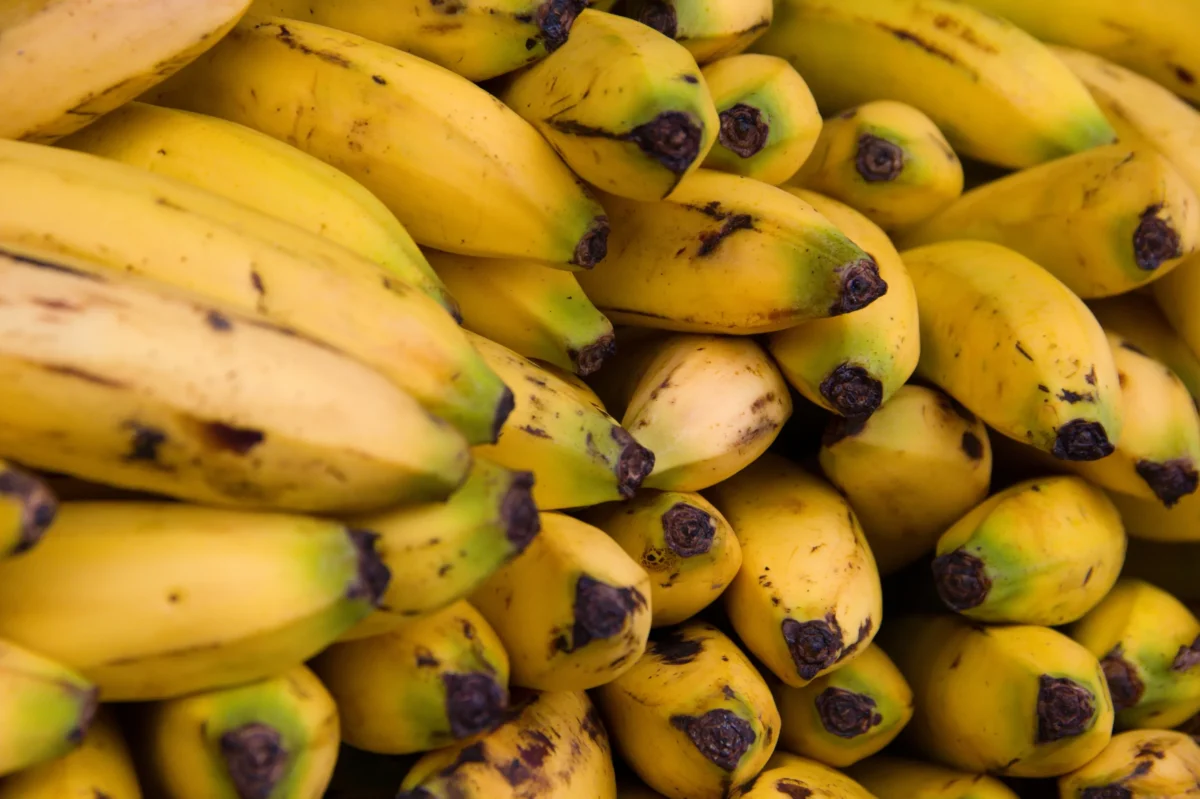Key Takeaways
- Gluten-Free Alternative: Banana flour serves as a versatile substitute for wheat-based flours, ideal for those with gluten sensitivities.
- Nutrient-Dense: Rich in dietary fiber, potassium, vitamins B6 and C, supporting overall health and digestion.
- Low Glycemic Index: Helps regulate blood sugar levels, beneficial for individuals managing diabetes.
- Sustainable Choice: Promotes environmental sustainability through responsible farming practices and reduced agricultural waste.
- Versatile Usage: Perfect for baking, cooking, and as a thickening agent in soups, stews, and sauces.
- Easy Substitution: Can replace up to 25% of regular flour in recipes with minimal adjustments needed.

Have you ever heard of banana flour? It’s a surprising addition to any kitchen pantry that’s been gaining attention for its versatility and health benefits.
I love exploring new ingredients, and banana flour is no exception. Whether you’re gluten-free or simply looking to try something different, this unique flour can elevate your favorite recipes in unexpected ways.
In this article, I’ll walk you through what banana flour is and share some easy tips on how to use it in your cooking and baking adventures.
What Is Banana Flour

Banana flour is a gluten-free alternative made from green bananas. It’s popular for its neutral flavor and versatile uses in cooking and baking.
Definition and Origin
Banana flour is produced from unripe green bananas. The bananas are peeled, dried, and milled into a fine powder. This method maintains the high starch content and extends the shelf life, making it a practical ingredient for various recipes.
Nutritional Profile
One cup of banana flour contains approximately 90 calories and 22 grams of carbohydrates. It offers 3 grams of dietary fiber and less than 1 gram of fat. The flour is rich in potassium, providing about 10% of the daily recommended intake per serving, along with vitamins B6 and C.
Benefits of Banana Flour
Banana flour provides numerous advantages, enhancing both dietary choices and environmental sustainability.
Health Benefits
Banana flour supports a healthy diet through its nutritional profile and functional properties.
- Gluten-Free: Suitable for individuals with celiac disease or gluten sensitivity, banana flour serves as an excellent alternative to wheat-based flours.
- High in Fiber: With 3 grams of dietary fiber per cup, it aids digestion and promotes satiety.
- Rich in Potassium: Each serving delivers approximately 10% of the daily recommended potassium intake, essential for heart health and muscle function.
- Low Glycemic Index: Helps regulate blood sugar levels, making it beneficial for people managing diabetes.
| Nutrient | Amount per Cup |
|---|---|
| Calories | 90 |
| Carbohydrates | 22 g |
| Dietary Fiber | 3 g |
| Potassium | 400 mg |
| Vitamin B6 | 0.5 mg |
| Vitamin C | 15 mg |
Environmental Impact
Choosing banana flour contributes positively to environmental sustainability through responsible agricultural practices and reduced waste.
- Sustainable Farming: Banana cultivation typically requires fewer pesticides compared to other crops, minimizing environmental pollution.
- Waste Reduction: Utilizing green bananas for flour production helps decrease agricultural waste, as unripe bananas are often discarded.
- Lower Carbon Footprint: The drying and milling process of banana flour consumes less energy, resulting in reduced greenhouse gas emissions.
- Biodegradable Packaging: Many banana flour products use eco-friendly packaging materials, further supporting environmental conservation.
How to Use Banana Flour
Using banana flour in your kitchen opens up a world of delicious possibilities. Here are some of my favorite ways to incorporate it into your recipes.
Baking with Banana Flour
I love baking with banana flour because it adds a subtle sweetness and moist texture to baked goods. You can replace up to 25% of regular flour with banana flour in cakes, muffins, and cookies. For example, try using it in banana bread for an extra banana boost. It works well in gluten-free baking, providing structure and elasticity similar to wheat flour.
Cooking and Thickening Agent
Banana flour serves as an excellent thickening agent in soups, stews, and sauces. I mix a tablespoon of banana flour with water to create a slurry, then stir it into the dish to achieve the desired consistency. It thickens without altering the flavor, making it perfect for both savory and sweet dishes. Additionally, you can use it to thicken smoothies and protein shakes for added creaminess.
Substituting Banana Flour in Recipes
Substituting banana flour is straightforward and flexible. Replace up to 1 cup of regular flour with banana flour in most recipes without significant changes. However, because banana flour absorbs more liquid, you might need to adjust the moisture content. For instance, when making pancakes, add an extra 2 tablespoons of liquid for every cup of banana flour used. This substitution works well in breading for meats and vegetables, offering a gluten-free alternative that crisps up nicely when fried or baked.
Where to Buy and Storage Tips

Finding high-quality banana flour is easier than you might think. I usually start by checking local health food stores, which often carry specialty flours like banana flour. If you prefer online shopping, websites like Amazon, Bob’s Red Mill, and specialty gluten-free retailers offer a variety of brands. Farmers’ markets are another great option, especially if you want to support local producers.
When purchasing banana flour, consider the following:
- Brand Reputation: Choose brands with positive reviews and transparent sourcing.
- Packaging: Look for airtight packaging to ensure freshness.
- Certifications: If you need gluten-free or organic options, verify the certifications on the label.
Storage Tips
Proper storage extends the shelf life of banana flour and maintains its quality. I store my banana flour in an airtight container to protect it from moisture and pests. Keeping it in a cool, dark place like a pantry works best. For longer storage, especially in warm climates, transferring it to the refrigerator or freezer prevents rancidity and preserves its nutrients.
Storage Recommendations:
- Airtight Containers: Use glass jars or high-quality plastic containers.
- Cool Environment: Store away from heat sources to avoid degradation.
- Avoid Humidity: Keep away from areas with high moisture to prevent clumping.
- Labeling: Date your containers to track freshness and use within six months for optimal quality.
By following these tips, you can ensure your banana flour remains fresh and ready for all your culinary adventures.
Conclusion
Discovering banana flour has been a game-changer in my kitchen. Its versatility opens up so many possibilities, whether I’m baking a new treat or thickening a favorite sauce. I love how it not only caters to my gluten-free lifestyle but also adds a unique twist to my recipes. Exploring banana flour has made cooking more enjoyable and sustainable for me. I’m excited to continue experimenting and can’t wait to see what delicious creations lie ahead. If you haven’t tried banana flour yet, give it a go and see how it can transform your culinary adventures.
Frequently Asked Questions
What is banana flour?
Banana flour is a gluten-free alternative made from unripe green bananas. The bananas are peeled, dried, and milled into a fine powder. This process preserves the high starch content and extends the shelf life, making banana flour a versatile ingredient for various recipes. It offers a subtle sweetness and can be used in baking, thickening soups, stews, and sauces. Banana flour is ideal for those seeking gluten-free options or looking to experiment with new flavors in their cooking and baking projects.

What are the nutritional benefits of banana flour?
« Nanotechnology in Banana Preservation: How It Extends Freshness and Reduces Waste
Banana Oil: Uses and Benefits You Didn’t Know About »
One cup of banana flour contains approximately 90 calories, 22 grams of carbohydrates, and 3 grams of dietary fiber. It is rich in potassium, providing about 10% of the daily recommended intake per serving, along with vitamins B6 and C. Additionally, banana flour has a low glycemic index, making it suitable for individuals managing diabetes. Its high fiber content supports digestive health, while the essential vitamins contribute to overall well-being.
Is banana flour gluten-free?
Yes, banana flour is completely gluten-free. It is an excellent alternative for individuals with celiac disease or those who are sensitive to gluten. Being naturally free from gluten, banana flour can be used in a variety of gluten-free recipes, including baking cakes, muffins, and bread. It provides a suitable texture and subtle sweetness, making it a versatile ingredient for those avoiding gluten in their diets.
How can I use banana flour in cooking and baking?
Banana flour can be used in baking by substituting up to 25% of regular flour in recipes like cakes and muffins to add subtle sweetness and moisture. It also serves as an excellent thickening agent for soups, stews, and sauces. When substituting banana flour in recipes, you may need to adjust the liquid content. Its versatility makes it suitable for both sweet and savory dishes, allowing you to experiment with different flavors and textures in your cooking and baking endeavors.
Where can I buy high-quality banana flour?
High-quality banana flour can be purchased at local health food stores, online retailers like Amazon and Bob’s Red Mill, and at farmers’ markets. When selecting banana flour, consider factors such as brand reputation, packaging quality, and certifications to ensure you’re getting a pure and reliable product. Checking reviews and opting for trusted brands can help you find the best banana flour for your culinary needs.
How should I store banana flour to maintain its freshness?
To keep banana flour fresh and maintain its quality, store it in airtight containers in a cool, dark place away from humidity. Avoid exposure to direct sunlight and moisture, which can degrade the flour and reduce its shelf life. Proper storage in a dry environment helps preserve the nutritional benefits and ensures that the banana flour remains ready for all your cooking and baking adventures.
What are the environmental benefits of using banana flour?
Choosing banana flour contributes to sustainability through responsible farming practices and waste reduction. The production process utilizes unripe green bananas, which might otherwise go to waste, thereby minimizing food waste. Additionally, banana flour typically has a lower carbon footprint compared to traditional flours, and many brands use biodegradable packaging, further reducing environmental impact. These factors make banana flour an eco-friendly choice for environmentally conscious consumers.
Can banana flour be used as a thickening agent?
Yes, banana flour is an excellent thickening agent for soups, stews, and sauces. Its high starch content allows it to effectively thicken liquids without altering the flavor significantly. When using banana flour as a thickener, it’s important to adjust the liquid content in your recipe accordingly to achieve the desired consistency. This makes banana flour a versatile ingredient for enhancing the texture of various savory dishes.
Is banana flour suitable for individuals with diabetes?
Banana flour has a low glycemic index, making it suitable for individuals managing diabetes. Its high fiber content helps regulate blood sugar levels by slowing down carbohydrate absorption. Additionally, the potassium and vitamin content support overall health. When incorporated into a balanced diet, banana flour can be a beneficial ingredient for those looking to maintain stable blood sugar levels while enjoying a variety of foods.
What are the taste and texture differences when using banana flour compared to regular flour?
Banana flour offers a subtle sweetness and adds moisture to baked goods, which can enhance the flavor and texture of recipes like cakes and muffins. It has a slightly grainy texture compared to regular wheat flour but blends well when properly incorporated. While it may not provide the same elasticity as gluten-containing flours, it contributes unique flavors and can create a tender crumb in gluten-free baking. Experimenting with banana flour allows for creative variations in both taste and texture.














